What are the real differences between boys and girls?
What really makes a boy a boy and a girl a girl?
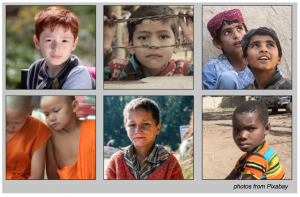 The boys in these pictures will lead very different lives in very different parts of the world. They will have some shared experiences but the thing that unifies them all is their biology. A male child has XY chromosomes. They are of the heterogametic sex and their reproductive organs, which become functional during puberty, are the penis and testes.
The boys in these pictures will lead very different lives in very different parts of the world. They will have some shared experiences but the thing that unifies them all is their biology. A male child has XY chromosomes. They are of the heterogametic sex and their reproductive organs, which become functional during puberty, are the penis and testes.
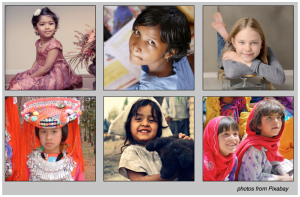
The girls in these pictures will lead very different lives in very different parts of the world. They will have some shared experiences but the thing that unifies them all is their biology. A female child has XX chromosomes. They are of the homogametic sex and their reproductive organs, which become functional during puberty, are the ovaries and uterus.
Yes, this is simplistic. It is absurd to have to state the obvious, but we need to get this straight from the start. Male. Female. One species. Two sexes. Sometimes things go wrong and children are born intersex. Being intersex is a genetic and physical condition and has nothing to do with the psychological condition of transgenderism. I’ve mentioned this elsewhere but it should also be mentioned here. The Intersex Society of North America has this to say:
People who have intersex conditions have anatomy that is not considered typically male or female. Most people with intersex conditions come to medical attention because doctors or parents notice something unusual about their bodies. In contrast, people who are transgendered have an internal experience of gender identity that is different from most people… these two groups should not be and cannot be thought of as one.
While ‘girl’ and ‘boy’ are definitions based on reproductive potential, that doesn’t mean all boys and girls will reproduce. Some girls may never menstruate; some boys may never produce sperm. These are physical conditions that occur when biological development goes wrong and they have nothing to do with brain function or transgenderism.

Girl and boy, female and male, woman and man are, and always have been, descriptors of sex categories.
Masculine and feminine are descriptors of behaviours that a given culture associates with being male or female.
Individual brains are a mosaic of these behaviours. We are not born with pink or blue brains. We all have personalities and they are all different.
Christia Spears Brown, PhD, a developmental and social psychologist asks:
“Why does the myth of pink brains and blue brains stick so firmly in our collective consciousness? … My husband and I are sincerely different. This is primarily because we come from different cultures, mine (the culture of being raised as a girl) encouraged emotional expression, and his told him that “boys don’t cry.”
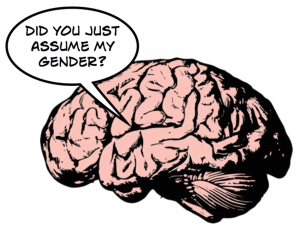 So what ARE the physical differences? Well, firstly, you can’t tell a girl from a boy by the size or patterns of their brain.
So what ARE the physical differences? Well, firstly, you can’t tell a girl from a boy by the size or patterns of their brain.
You can make generalisations: boys’ brains are usually slightly bigger than girls’, although girls’ brains usually have more ‘folds‘ which gives them an increased surface area. Boys are slightly bigger than girls so this makes sense. (BTW it’s surface area which determines how many neurons and synaptic connections the brain can store. So size isn’t everything.) Girls reach puberty before boys. These are physical differences. Some minor sex differences in the brain may exist but an individual brain is… well… an individual brain. It’s also impossible to predict what mix of features any one brain may have. You can read more about this here, here and here.
Neuroscientists cannot tell whether any random brain is male or female.
“We separate girls and boys, men and women all the time. It’s wrong, not just politically, but scientifically – everyone is different.”
Daphna Joel
You can read Daphna Joel’s study ‘Sex beyond the genitalia: The human brain mosaic’ here.
Human brains develop through experience. Show 6-12 month old babies a truck and a doll and both will prefer the doll. There is no scientific basis for all of our stereotypes and prejudices about what boys and girls should and shouldn’t do.
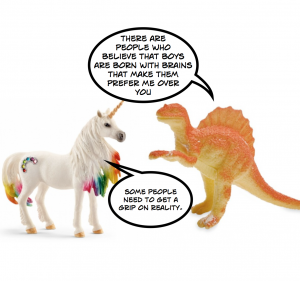 Yet this neutrality quickly changes. Ask a group of five or six year old children which of these fairly non-gendered Scleich toys is meant for boys and which for girls, and most of them will be pretty clear about what they are expected to say. It is pretty safe to assume that human children have not evolved to have a specific preference for a certain style of plastic toy depicting an unfamiliar species of creature. Kids learn which behaviours meet with approval, and generally, they follow them.
Yet this neutrality quickly changes. Ask a group of five or six year old children which of these fairly non-gendered Scleich toys is meant for boys and which for girls, and most of them will be pretty clear about what they are expected to say. It is pretty safe to assume that human children have not evolved to have a specific preference for a certain style of plastic toy depicting an unfamiliar species of creature. Kids learn which behaviours meet with approval, and generally, they follow them.
Tricia Lowther who works with Let Toys be Toys tells the story of buying her car-loving daughter ‘Cars’ juice cartons instead of princess ones. Her daughter hid the cartons and told her mother they were ‘boyish’. She liked cars, she assured her mother, “but I don’t want anyone to know.'”
The images below are of things that are not especially ‘gendered’ yet we can all identify in a flash which girls and boys are ‘supposed’ to prefer.
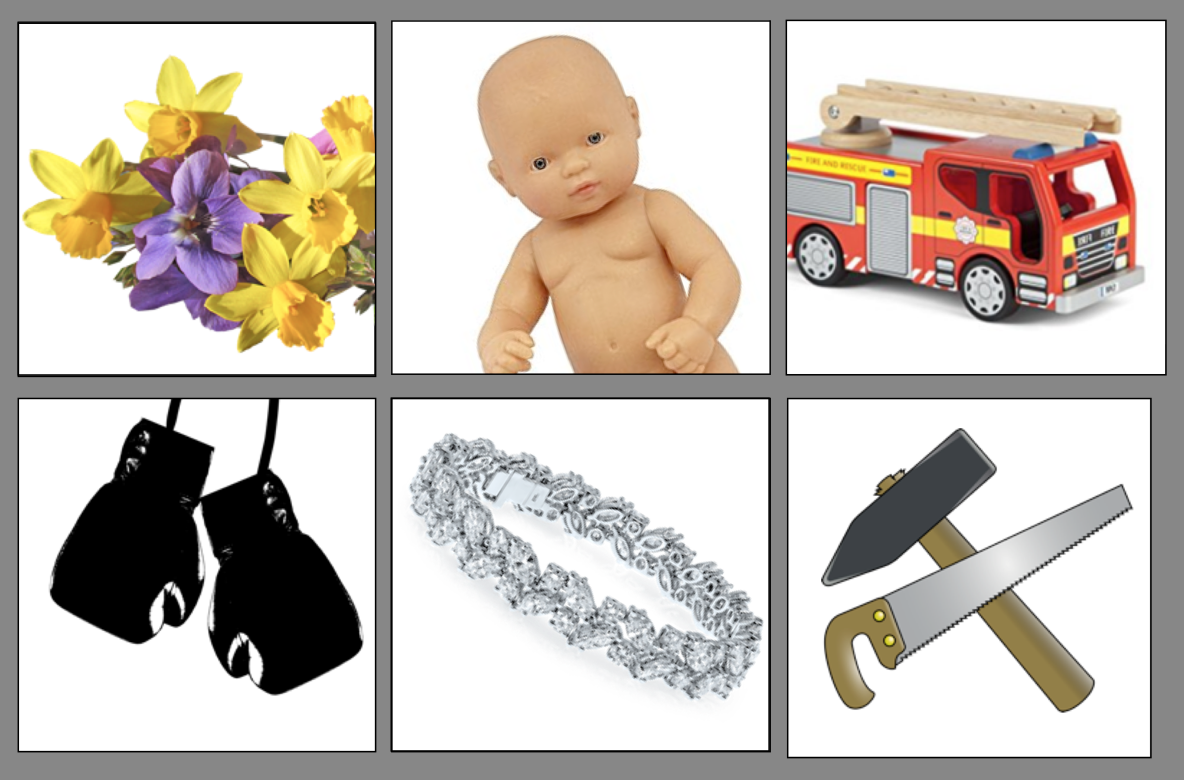
Nowadays, we are more gendered than ever. Even toys like magic sets, Lego and globes are now marketed to girls in varying shades of pink. By the time a girl is four she has a pretty good idea that she is ‘supposed’ to like all things pink, whereas a boy has a pretty good idea that he is not supposed to like pink- or flowers, or hearts or love. A boy is supposed to like trucks and superheroes and breaking things. A boy is LOUD. A girl is QUIET. A loud girl is bossy, but a loud boy is the boss.
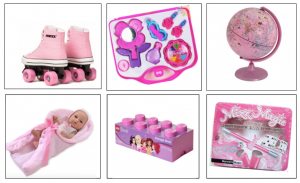
As Alice Baumgartner-Papageorgiou discovered in her 1982 study (see Joan Ferante’s ‘Sociology- A Global Perspective’) boys and girls know their lives would be very different if they were the opposite sex. Boys believe life would be worse and girls that it would be better. From ‘I’d have to shave my whole body’ and ‘I couldn’t have a pocket knife‘ (boys) to ‘people would take my decisions and beliefs more seriously’ (girls) it become clear that kids are aware of the different rules for the sexes, and many become understandably confused if they don’t have a natural inclination to follow them.
Where does that leave the children that don’t fit the stereotypes? Who is pushing these stereotypes onto kids? Surely none of us want to restrict or limit our children?
I once went to a swimming party with my youngest, then aged 4. The house was a large white-bricked Victorian terrace in St John’s Wood with its own pool; the hosts educated and hipster. Many of the mums had their own high-flying careers. If I’d asked them if they treated boys and girls differently, I imagine they would have said no. I didn’t ask. Throughout the afternoon I watched as the boys were praised for their jumping and splashing and the girls were praised for how pretty their swimwear was and how nicely they played together. The girls jumped and splashed. Not all of them played ‘nicely’. The boys had cool swimwear and played together too. None of the adults did this consciously – they just did it.
Globally, of course, sexism runs far deeper than the thoughtless damage done at middle class swimming parties. What separates girls from boys is not flower-and-love-heart bejewelled swimsuits and Incredible Hulk swimming trunks. Girls are discriminated against because of their female biology, not because they have an innate desire to wear sparkly pink tops and giant Jojo bows.
Female foetuses are more likely to be aborted; girl babies starved; girl children sexually assaulted. Girls are subject to more media pressure about their bodies, more likely to be valued for their bodies and exploited for their bodies through prostitution or surrogacy. Girl children are more likely to be raped & more likely to be subject to physical abuse from those close to them. Girls are less likely to receive an education; less likely to be able to read; more likely to be married young.
It is not possible for boys to identify into, or girls to identify out of, these outcomes. They happen to girls because they are female-bodied.
This is the crux of the matter. If we can really understand this (below), we can start to realise how we have reached a point where we are happily transitioning children, telling them they are born in the ‘wrong’ body and deluding them into thinking this is something they can change. The problem is not the children, it is the importance that society attaches to stereotypical behaviours.
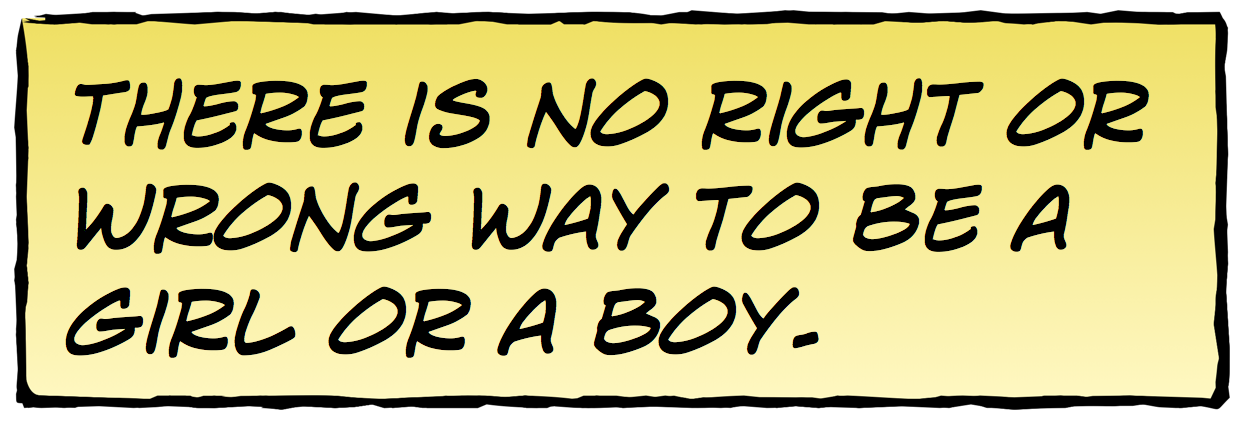
Toys and fashions change. Our preferences for certain things are not innate. In many cultures, boys wear skirts or dresses and long hair is just fine. Nobody tells them they are girls. Time, location and situation all affect what is considered to be ‘normal’ gendered behaviour.

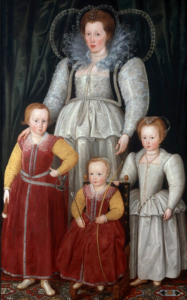
Historically, pink was considered a boy’s colour, a watered down version of red, the colour of Mars and war. Little Henry Wentworth is pictured here (1596) in a dark pink/ burgandy dress (his sister & mother wear white) with his curled hair tucked into a lace bonnet. He was the very epitome of youthful masculinity at the time.
Here are a few thoughts from Twitter on the history of gender conventions through the ages.



 Yes, let’s not forget the ever-changing dictates of fashion. While those of us who grew up female in the 70s and early 80s were spared the horrors of pinkification, these warlike paragons of 16th and 17th masculinity were were happy to wear dresses and pretty keen on their heels. There’s an excellent article about historical men’s clothing by Purple Sage, here.
Yes, let’s not forget the ever-changing dictates of fashion. While those of us who grew up female in the 70s and early 80s were spared the horrors of pinkification, these warlike paragons of 16th and 17th masculinity were were happy to wear dresses and pretty keen on their heels. There’s an excellent article about historical men’s clothing by Purple Sage, here.
The biggest difference between male and female brains? Male brains are found in men’s heads & female brains are found in women’s heads. That’s biology. Man. Woman. Girl. Boy. We need those words to describe sex differences and we need them more than ever because of the differences that form after we are born.
There are undoubtedly some differences at birth. Boy and girl babies are born with different hormone levels. Male babies are said to be born with as much testosterone as a 25 year old man (these levels fall rapidly after birth). Lise Eliot argues that infant brains are so malleable that these few small differences at birth become amplified over time, as society, teachers and parents – like the ones at our swimming party – unwittingly and generally well-meaningly, reinforce gender stereotypes. So what does this mean for girls?
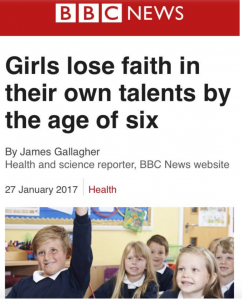 As Sarah Ditum wrote scathingly in The New Statesman:
As Sarah Ditum wrote scathingly in The New Statesman:
“Here’s a story we like to tell ourselves. Once upon a time, we were sexist, but then feminism happened and now we’re not sexist anymore. But boys and girls carry on being different because they are different.”
In the BBC TV program ‘No More Boys and Girls’ Dr Javid Abdelmoneim finds that at age seven, boys are more likely to overestimate their abilities and girls to underestimate theirs- yet at this age there is no difference in the strength or abilities of boys and girls.
As Ditum observes ‘Genitals aside, they’re simply kids.’
So why are we pedaling the narrative that liking certain toys or clothes makes a child ‘transgender’?
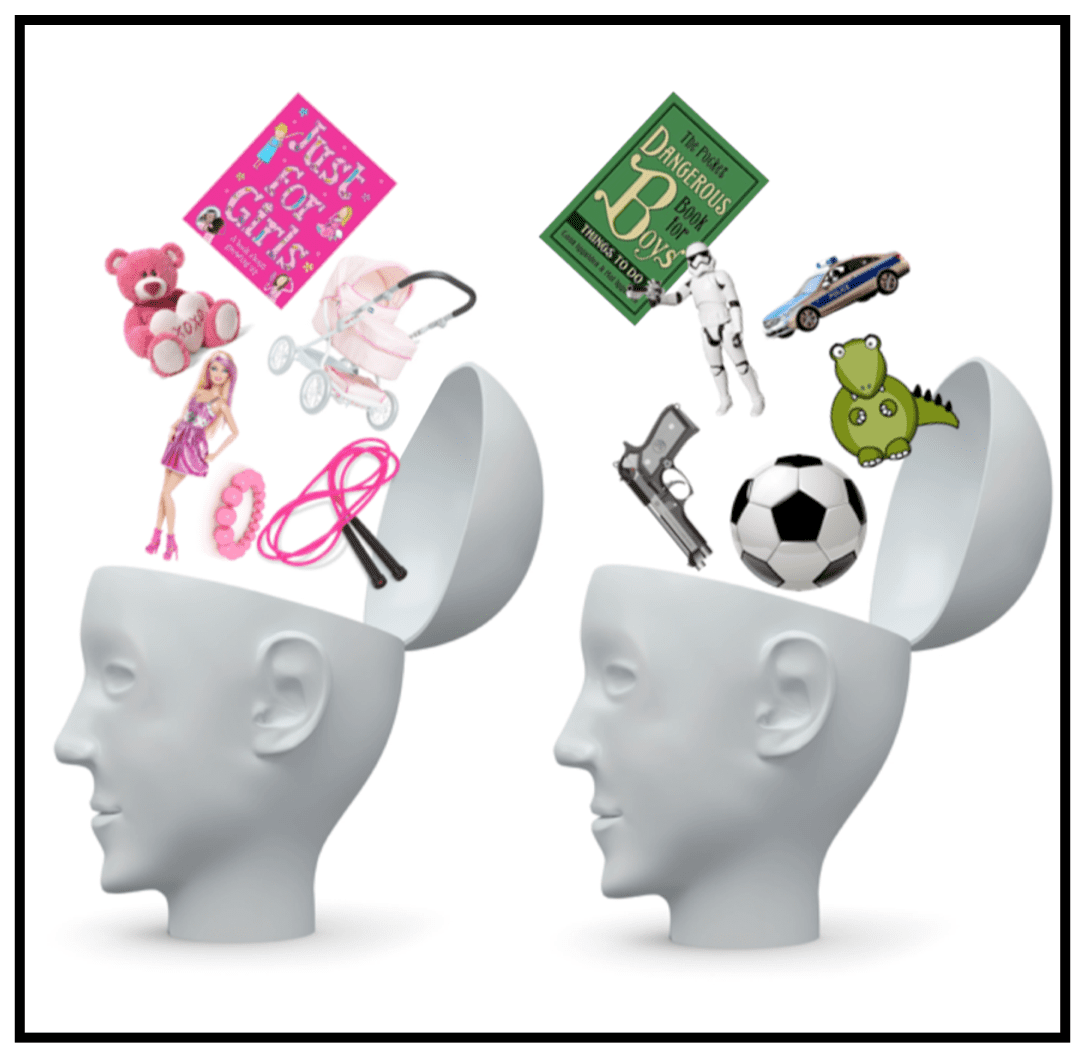
Almost from the day we are born, those around us respond differently to girl and boy babies. Adults perceive infant girls as smaller, softer, and finer featured (Rubin, Provenzano, & Luria,1974) and handle boys more roughly than girls (Lewis, 1972).
One study showed that mothers of new born boy babies tended to describe them as ‘stronger’ although there was nothing to suggest this was the case. Another showed that when mothers of 11-month-old infants estimated their babies’ ability when crawling down slopes, mothers of girls underestimated their performance and mothers of boys overestimated their performance. This bias had no basis in fact. Girls and boys achieve early motor milestones such as reaching, sitting, crawling and walking at roughly the same ages.
So we take these small differences, mix them up with our expectations of male and female development, and as a result many of our projected outcomes become reality. Most kids want to please. Girl toddlers generally – #notallgirltoddlers – receive approval when they play with dolls: adults around them smile and admire their nurturing qualities. Boy children are smiled on indulgently when they dash round screaming: they are blowing off steam and ‘boys will be boys’. Girl children have their clothing and their hair admired. Boys have their power and their energy admired. Boys are taught to focus on themselves, girls are taught to focus on others. Those who doubt the truth of this need to look no further than the kids’ clothing section of Primark on Oxford Street where I took these six photos on the same day.

Boy’s T shirts are about ‘bigging up’ the boys. Girl’s T shirts are about beauty and compassion.
A girl is not an ‘epic dude’ or an ‘awesome kid’. A girl ‘sees beauty in everything’; she is ‘mummy’s little lady’ and a ‘little love’. A girl can step outside this box but only by crossing over, physically and metaphorically, into the section clearly marked ‘BOYS’.
When my facebook friends and friends-of-friends post pictures of their daughters, most of the comments are along the lines of how ‘pretty’ ‘stunning’ ‘gorgeous’ or ‘beautiful’ the girl is. This happened most recently on a thread where a friend had posted a picture of her daughter who had just won a medal at a top Judo competition.
Sociologists call the process of pushing girls and boys down different paths ‘canalisation’ and it is canalisation that Juno Dawson refers to when he writes about his childhood.
“When I merrily skipped across the playground, I was told to walk. When I chose My Little Ponies at the toy shop, I was firmly told no.”
Susie Green, CEO of Mermaids tells us, in her TED appearance, that she was ‘terrified’ when her 4 year old son told her he was really a girl. Green’s husband made her throw away all the ‘girly’ toys and clothing in the house because he ‘did not approve of our child’s effeminate behaviour’. In order to dress in a skirt for school, be allowed to play with tutus and Barbies, and wear his hair long, her child had to ‘live as a girl’. He was taken abroad where he underwent full ‘gender reassignment surgery’ at just sixteen.
Her son, singer, model and ex-pageant princess, Jacky Green, now 24, says
“It’s in my DNA. I am a girl.”
It isn’t, of course.
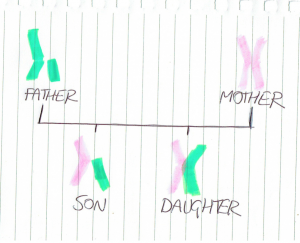 Some parents seem to believe that medication and surgery are both inevitable and essential for their trans-identifying children. Some of these parents are giving advice to the worried parents of children who do not conform to gender stereotypes. Susie Green, for example, tweeted as recently as June 2016 that ‘between your ears needs match what’s between your legs’.
Some parents seem to believe that medication and surgery are both inevitable and essential for their trans-identifying children. Some of these parents are giving advice to the worried parents of children who do not conform to gender stereotypes. Susie Green, for example, tweeted as recently as June 2016 that ‘between your ears needs match what’s between your legs’.

If you’ve read Part 1 of this article, you’ll remember it ends with Corey Maison’s mother talking about how he is ‘looking forward’ to undergoing sex-change surgery at 18. It all sounds so reasonable and sanitised. We hear cute stories about Jazz Jennings and other kids asking when the ‘gender fairy’ will ‘fix’ them, and how ‘God made a mistake’ and we imagine that science and technology have reached a point where it is easy to recreate functioning genitalia. The gender fairy waves her wand and ‘hey presto!’ everything is fine. In fact the reality is quite different.

The next bit of this article is a bit gruesome, but believe me, it’s nowhere near as gruesome as it could have been. The photos I’ve chosen to feature here are not extreme examples, importantly they are not surgeries that are considered failures. If you want – and I wouldn’t advise it – you can find many many more photographs of faux genitalia via a few clicks on Google.
Here are some of the results of female ‘gender reassignment surgery’.

A neopenis is made with skin taken from the arm or thigh. Some are fuctional for sexual intercourse but will need a pump to help mimic an erection (and to deflate it afterwards). Many neopenises get infections; some leak a slow but steady trickle of urine. Surgeons are still experimenting with the procedure. Can a child really understand this? Does the little girl who is told she can ‘become a boy’ and ‘get a willy’ when she grows up have the ability to grasp the implications of such surgery?
Here is what happens to a male when he undergoes ‘gender reassignment surgery’.

A ‘neo-vagina’ will need dilating several times a week forever, because the body feels it as a wound and tries to heal it. Sometimes a male will experience ‘phantom penis syndrome’ where he feels as if he still has a penis when he become aroused. In reality, a functioning vagina is not created. The best a boy can hope for is that he will end up with some sort of flesh-tunnel, a ‘penis sheath’ that enables him to be penetrated from the front.
And here are some girls who have had ‘top surgery’.
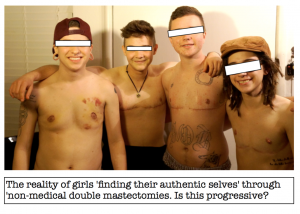
The photos above are not what gender- confused teenage kids see when they look on YouTube. They see videos like this . It all looks so simple. The scars from surgery; the acne from testosterone injections are photoshopped away and the happy smiles say that all is well. Young people that transition seem to think they are breaking gender stereotypes: in fact they’re conforming so utterly and entirely that they can’t even see it themselves. In reality, levels of self-harm, eating disorders and suicidal thoughts rocket among trans-identified children and young people.
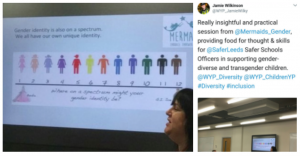
So, surely adults in positions of power are speaking out against transitioning children? Quite the contrary. This week it was revealed that Mermaids are currently making presentations to the police seriously suggesting that a young person’s ‘gender identity’ falls somewhere between Barbie and GI Joe – and the police are calling it ‘insightful and practical’.
So where does all this leave the idea of ‘real’ transgender children? In the 80s, when girls had short hair and ‘girl toys’ weren’t all pink, GNC behaviour would have usually been looked upon as a sign that a child was probably going to be gay. No more. No need to pray the gay away – a girl can ‘become’ a boy now! Except she can’t.
Despite having read everything I can get my hands on and watched YouTube videos til I feel like my eyes need bleaching, I can find nothing that suggests it’s actually possible for a child to be born in the wrong body. Whatever ‘real trans’ might be, I’ve yet to read anything that convinces me it’s anything beyond problems dealing with stereotypes. I have asked over and over again for someone to answer ‘What makes a child transgender?’ and been met with only silence, stereotypes and/or circular definitions.
I don’t for one minute deny that these kids are confused and that they really believe they are ‘born in the wrong body’ but the fact is that they are not. We need to be changing society, not our children: teaching children to love their unique, wonderful, powerful bodies, not making them part of the problem. We are depriving children of the experience of puberty – rarely fun for any of us, but essential to our development – with puberty blocking medications, and changing hormone balances at crucial times in the development of young brains. We are putting children on hormone treatments that render them sterile. This is not progressive, this is eugenics.
A child who believes that they’re something they are not is suffering from a mental, not a physical problem which is made worse by a society that worships gender stereotypes and by adults who tell kids ‘Yes, you are wrong and you can be fixed- like this’.
I can understand that worried and confused parents want to do what’s best for their child, I really can. I’ve been there. But a child cannot even begin to understand the implications of ‘gender reassignment surgery’ & a lifetime as a medical patient.
Time will tell how the fashion of transitioning of GNC kids works out and I fear it will be badly. We need to teach kids that it’s ok to smash stereotypes, not worship them.

There will be an avalanche of lawsuits in the future as a result of all this. A lot of people are making decisions, on behalf of others, that will have very serious consequences.
An excellent essay, once again!
Thank you Lily, once again.
Thank you for highlighting the harm caused by telling children they can change sex, as if altering their bodies is as easy as changing hairstyles and clothes. I only hope that more people start listening and stop cheerleading this lunacy.
I’m following your blog.
Transgender worries me.
Some of what you write I agree with, some I don’t.
But these days, anyone who questions transgender seems to be considered in ‘polite society’ to be part of the Alt-Right. However, I do not consider I am ‘right-wing’; rather I am one of the very rare species, the ‘questioning left’.
Thanks for what you are writing here. And the useful links.
Theo H
Theo right there with you. I am a gay, bernie supporting, pinko lefty who thinks most illicit junk should be made legal, who believes throwing money at a problem is a great way to solve it and thinks we should have given the forclosed housess to the peopele not the banks and I get accused of being either alt right or a colaborator all the time cause I question things like trans kids and believe in pesky things like due process.
Pingback: Transwomen are Men | Lily Maynard
This article is what I’ve been searching for, hoping that with enough research and consideration I would have been able to compose this myself. Well thank you Lily! You have saved me some writing time. I have diverse friends and have been trying to look at this issue without bias, I am a woman, and therefore I recognise that I cannot account entirely for all the bias I might hold. I am a woman who self-identifies as having fluid sexuality (to try and define my sexual preference at any one time is difficult as my menstral cycle and the individual people play a part in my experience of attraction to others).
During my life, I have had periods when I have questioned my identity as a woman and I have yearned to become a man so deeply and honestly. This has been a learning process and experience that I value, and thank goodness that surgery, hormones or other permanent life-changing practices were not available to me at such times. Like the time when I was 6 years old, stood on the lid of the toilet seat so I could ponder in the mirror at how masculine/feminine my face was with my hair scraped back. Wanting at that time to become a boy, to live in a world where I was treated like my younger brother, who was treated differently to me by everyone in a stereotypical way.
My sexuality was already not heterosexual and I was too young to comprehend this at this time and as how it related to me. Hell, I spent a large amount of my early 20’s in the Village (Gay by name LGBT more recently) and still felt excluded, as I wasn’t a stereotypical lesbian and I was branded as, confused, experimental, fake and was turned away from bars until I cut my long hair short and cut out the makeup. Funnily enough, this was the period in my life that I experienced the longest and most intense need to identify, live and love as a man.
I didn’t need to become anyone other than my true self, I have, thankfully, had the time and space to reflect on this experience and in hindsight I am so glad I didn’t let the ineptitude’s of our society guide me down a path of body augmentation that was irreversible.
We need to protect each other from the harm, injustice and inequity faced by men, women and intersex people, sexual discrimination hinders everyone from reaching their full potential in, and with society, as a whole. I believe trans men and women are going through experiences that are not only medically psychological in nature, they are struggles instigated and perpetuated by our social judgments and classifications.
Recently a friend’s male child told his cousin that she couldn’t be a police officer because that was a boy’s job. This pearl of wisdom came from the adults caring for him at his nursery school, FEMALE ADULTS!!!!
We have such a long arduous journey ahead of us in making the world a safer place for individuals to express both the stereotypically feminine and masculine aspects of their sex. Yet to say the things I have mentioned, I leave myself open to judgment, discrimination and being labelled a bigot or a lefty, a queer, or transphobic. With this in mind, no wonder the trans debate is a minefield of judgement with a lack of real, valid discourse that could effectively remedy and resolve issues for many, many people.
I believe the hardest task we have in fighting social injustice at this moment is to try to empathise with people we view as judgemental, bigots and uneducated (to ‘our’ way of thinking).
Social media has brought about the opportunity for people to have meaningful, life-changing discourse and this freedom and learning curve is being quickly eroded by the use of the branding of ‘bigot’ related labels.
Why engage with debate if you don’t believe that there is hope to reach a compromise, or understanding with someone who has views that challenge what your social experience has led you to hold true. Even if you are adamant that you are right and just!
We are doing ourselves a disservice if we simply discard an individual, based on the perception that the label of bigotry we assign to them being permanent, without cause, and uneducated.
Empathy is key!
‘Why does the person who’s views I appose have such a view?’ That is the most important question we can ask ourselves when debating. For then we see the human, and learn about their concerns and conclusions in life, then we are able to truly change, for the good of all.
Pingback: How LGBTQIA+ teaching in schools erases lesbian & gay kids - Lily MaynardLily Maynard
Pingback: So your child thinks they might be transgender? Part 2 - resources for parents - Lily MaynardLily Maynard